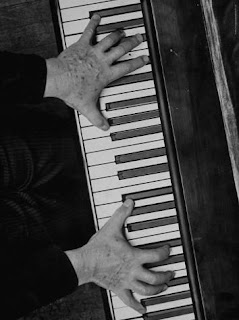Put on your headphones, here's a little listening this morning: this is Blues On My Mind from Blue Mitchell's album Out Of The Blue. A lot of blue there, and blues. Playing on it are Benny Golson, Wynton Kelly, Sam Jones, and Art Blakey on drums. Everybody sounds fantastic on it, I'm particularly in love with Sam Jones here.
The tune is a 12-bar blues, the feel is a nice relaxed shuffle. It's a hip tune, written by Benny Golson, not a stock hard bop item at all. There's no lead sheet for it in any of the usual books, you can purchase a transcription of the complete track (the head and solos anyway) via Qpress, a site that looks to be an excellent source for brass players.
Drummers tend to overplay when somebody mentions Blakey, shuffles, and hard bop. And when you give them/us an arrangement to play. So it's good to pay close attention to what's happening here, and dispel some perhaps one-dimensional concepts of those things. I know how you guys are, because I'm that way. Away from the actual thing you form these simplistic ideas about them. Maybe it's just me.
I would listen to this at least a half dozen times, including a couple times just paying attention to the quality of the groove, and the dynamics:
There are a number of stops and rhythm figures on the head, Blakey doesn't set them up except at the end of the form. He's very sensitive with the dynamics— the bar 1 is strong, bars 2-5 are soft, bars 6-12 are stronger. Each of those parts has dynamic movement within it. Check where he catches the cymbal and mutes it, or let's it ring out.
Blakey takes it easy, mostly playing straight time throughout, but he hits some pretty strong accents— usually at the end of solos. Most of us would be shy about punching them that hard when playing this smoothly overall.
As you would expect with a shuffle, he's keeping a straight rhythm on the cymbal, and there's some activity on the snare drum— a backbeat, and usually some part of the expected shuffle rhythm. At no point does he wail on the snare drum. He's playing the cymbal with a strong quarter note pulse, accenting on all four beats— he's not accenting just the 2 and 4, as if often stated about him. The hihat is on a solid regular 2 and 4 all the way. Blakey played the bass drum in his time feel, but I'm hearing none of it except for the accents. Maybe during the bass solo.
An aside: I don't know, once again, I think the popular concept of “feathering” is just misguided— especially as I see people focused on it to the exclusion of the audible elements. And as if it's one thing and one technique. The feeling I'm getting here is of a little pressure on the bottom with the foot, like the beater isn't even coming off the head.
The groove is seated very deep, and is definitely human created. As is often the case, you can feel the swing element being pulled some different directions. And the main pulse. There are some wild factors there. Religiously resolving everything to a perfect grid is a 21st century deformity— it's not what swing is. Blakey's cymbal beat is close to a dotted-8th/16th rhythm here; between the cymbal and the snare drum there's a suggestion of a double time feel at times. The soloists are generally swinging off more of a triplet foundation, when they're not double timing. The swing comes from the tension between the different concepts. In part.
For a moment I was going to say that this track is a lesson in not playing based on genre stereotypes, but stepping back it really is just a straightforward shuffle. I think the fact that I'm listening to this straightforward shuffle, and all I can hear is the ways that it's a unique piece of music, and not a genre stereotype, is a clue about how you're supposed to listen. It does help that these players are all so great, it makes the fact that we're hearing living music pretty unavoidable.































